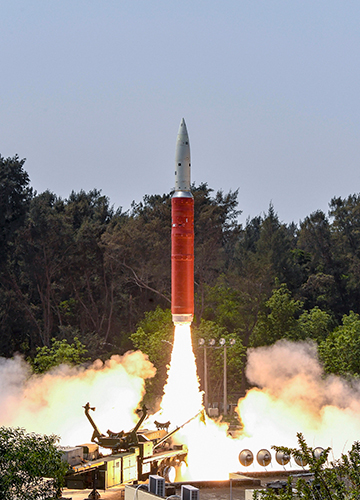HAVING SUCCESSFULLY TESTED an anti-satellite missile system in March, and then coming within 2.1km of soft-landing a rover near the south pole of the moon, our military and space scientists have two creditable achievements this year. Space offers an asymmetrical advantage to nations that can penetrate it, in terms of their capability to fulfil the needs of their people, security of the nations and, ultimately, economic leverage.
Post-World War II, there was a surge in space capabilities in developed nations at the civil and strategic levels. The Soviet Union and the United States took the lead in developing the requisite technologies and industrial base through national policies with a competitive spirit. European nations followed suit, as soon as they recovered from the trauma of the war.
We were not far behind. Driven by the vision of Dr Vikram Sarabhai and the systematic nurturing of mission mode programmes and procedures by Professor Satish Dhawan, India’s space mission has taken major strides. We have indigenously created state-of-the-art technologies and an associated indigenous supply chain to build systems, ground infrastructure and space assets. It is to our credit that all these were achieved in the backdrop of repeated technology sanctions and denial regimes, imposed by the west.
Militarisation of space is the development of weaponry and associated technologies for application in outer space to gain a definite edge over one’s adversaries. The first steps towards militarisation of space were taken soon after the Second World War by the two superpowers, the USSR and the USA. The initial intent was to remotely monitor the enemy’s strategic assets and the technologies they were developing.
Soon, C4I2SR (command, control, communications, computers, intelligence, information, surveillance and reconnaissance) became the mantra for integrating space-based assets for the militaries of these countries. Ballistic Missile Defence (BMD), underwater sensors, high-power microwave and laser weapons, supersonic and hypersonic cruise missiles also emerged. As other nations, including China and India, began to develop these technologies, there came a need for regulating them and setting up control regimes. The UN Committee On Peaceful Use of Outer Space (COPUOS) set guidelines with treaties to restrict weaponisation in space. The Space Preservation Treaty protected space from weaponisation; the Moon Treaty protected the moon and celestial bodies. The European Union brought a code of ethics to prevent the attempt of few countries at weaponisation of space, since space could be used for setting up large platforms. The Outer Space Treaty stated that the exploration and use of outer space shall be carried out for the benefit of and in the interests of all countries; that it shall be the province of all mankind, that the outer space must be kept free from nuclear weapons or other weapons of mass destruction in orbit, and that space must be kept free from harmful contamination of space debris.
All the same, the US, Russia and China are in the process of developing systems for weaponisation in case of future requirements. It was in this background that the Defence Research and Development Organisation (DRDO) started its guided missile programme under the leadership of Dr A.P.J. Abdul Kalam. Agni, with a 5,000km range, and its shorter-range versions tipped with nuclear payload, submarine-launched ballistic missiles and non-nuclear precision attack supersonic cruise missile, BrahMos, are today in India’s formidable armoury. These are meant to prevent war, since strength respects strength. These systems were developed, against the odds of technology denial through missile technology control regime (MTCR) and other control regimes, by harnessing capabilities within several institutions and industries, and forming national teams of young scientists. Thus, technology denied proved to be technology gained.
With the track record of many successful satellite systems and launch systems, ISRO embarked on parallel missions to support the armed forces. ISRO provided satellites for early warning, high-resolution pictures for enhanced situation awareness, electronic intelligence on movements of forces and equipment, communication, remote sensing and navigation. These inputs enable the armed forces to have battlefield situation awareness and integrated decision support systems for quick turnaround and capability for optimum use of all assets.
The Gulf War of 1991 brought home to us the importance of ballistic missile defence. Soon, India started a ballistic missile defence (BMD) programme with a unique two-layer system that can destroy any incoming missile at exo-atmospheric and endo-atmospheric altitudes using two types of multiple missiles. This system was evaluated in several flight tests. Adding a few more systems to BMD, India conducted an anti-satellite (ASAT) test on March 27, 2019, scoring a direct hit on a lower-speed live satellite in low earth orbit below 280km, so that the debris could decay and most of it would fall back on to earth. India’s test was necessary for establishing our capability to protect space assets. The USA, Russia and China had already conducted ASAT tests and India was the fourth nation to do it.
Also read
- National Space Day: Why it is a significant milestone in India's space journey
- Chandrayaan-3: 2 of 3 objectives achieved. What’s next
- Watch: ISRO shares video of Pragyan rover ramping down from Vikram lander
- Chandrayaan-3: Rover 'Pragyan' rolls out. See images captured by 'Vikram' lander
- Chandrayaan-3's Tamil connect: The soil from Nammakal and the three scientists
Unlike India’s ASAT test, China destroyed its satellite at an altitude of 1,000km and one of the pieces went within 6km of the International Space Station. Launch vehicles and ICBMs put their upper stages and the payloads in decaying orbits and they also become debris in space. All these tests have left more than one lakh pieces of debris in earth orbit. These are space junk, and pose a threat to active satellites and other space assets. This junk will have to be removed through some joint programme by leading spacefaring nations.
History has shown that every medium available will be used for war. Our epics have taught us that space is also one of the mediums of war—Meghnad could shoot arrows from the clouds. As the major arms-control treaties are being shelved between the US and Russia, and trade and economic wars have already broken out, it is a matter of time before satellites get weaponised with lasers, high-power microwaves and long-range missiles with hypersonic wave riders. The world may witness eventually network-centric warfare with satellites and missiles, and also conflicts in cyberspace, integrating artificial intelligence, robotics, the Internet of Things and blockchain.
Dr Pillai is former chief controller, DRDO, and former CEO of BrahMos.



